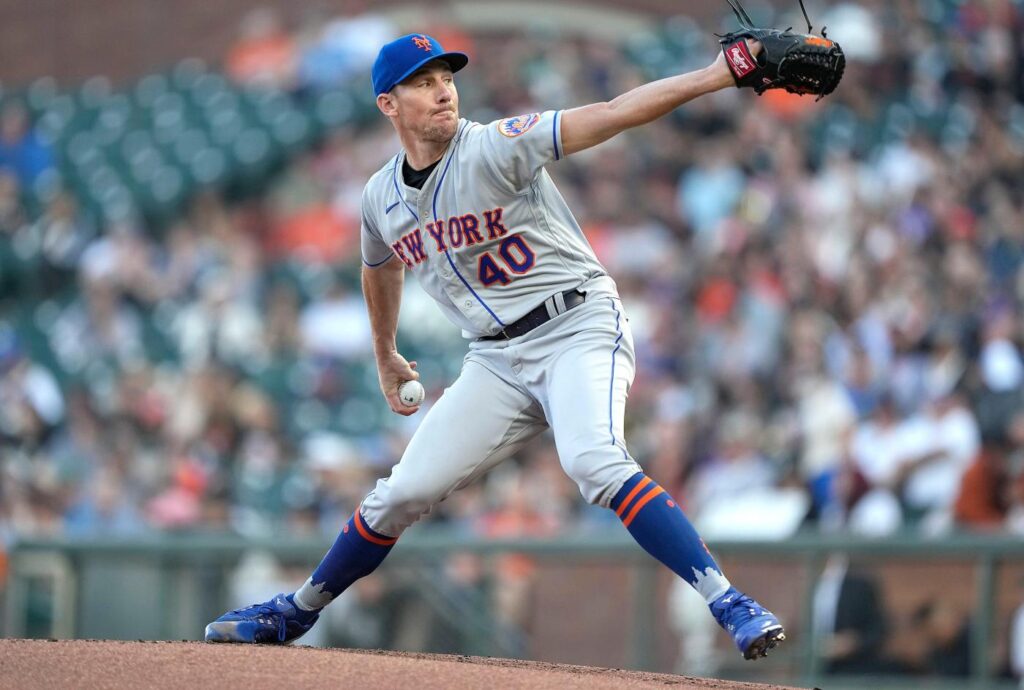
Chris Bassitt went from “I can’t,” to “Let’s just try it,” when it comes to PitchCom.
Last month, Bassitt was pretty skeptical of the play-calling system, which MLB implemented in the majors this year as an alternative form of a catcher giving finger signs and to prevent sign-stealing. With PitchCom, the catcher wears a device somewhere on his gear, whether it’s on his wrist, shin guard or chest protector, and will push a button that coincides with a given pitch, kind of like a remote control. The pitcher wears a small speaker in his cap and hears an automated voice calling the pitch that the catcher has selected.
“No, I just can’t. It would take too long,” Bassitt told the Daily News last month when asked if he’s tried the device. “The PitchCom is supposed to speed us up, but unfortunately MLB doesn’t let me call the pitches. The catchers have to push the button. I’m really hoping that MLB decides that I can push the button that I want to throw. That’ll speed it up.”
Flash forward five weeks and Bassitt has used PitchCom in his last two outings, against the Cardinals on May 19 and the Giants on May 24. So, what changed?
Well, it took a little convincing from catchers Tomas Nido and Patrick Mazeika to get Bassitt to budge.
“Bassitt is a challenge with his seven pitches,” Mazeika said. “We were able to convince him to go to the PitchCom. I was definitely happy about that. He needed some persuading there. We finally convinced him that there was a viable option with enough buttons to cover all of his pitches.”
For a starter like Bassitt, who has seven pitches in his arsenal, the PitchCom makes sense as a way to speed the game up and allow him to work faster by not having to wait for finger signs, shake off pitches, or carry out mound visits to go over signs again. Shaking off pitches, even when Bassitt is on the same page as his catcher, is a part of the right-hander’s routine when he’s on the mound. He’s been doing it throughout his eight years in the big leagues.
But those shake offs used to confuse Nido, who thought maybe that meant he was calling a bad game. Nido spoke to starting catcher James McCann about it, who told him that’s normal; it’s just how Bassitt pitches and it doesn’t necessarily mean he’s disagreeing with the pitch Nido is calling. Bassitt also told Nido they’re largely on the same page. So that was a relief to Nido, but he still figured PitchCom could save both him and Bassitt the hassle and speed up the tempo of the game.
“I talked to him about it,” Nido said. “And now PitchCom is his new best friend.”
Bassitt wasn’t buying the new concept in April in part because PitchCom wasn’t really speeding the game up yet. Mets catchers were still learning the new device, including memorizing which button called a given pitch and figuring out where the wearable sleeve felt comfortable. McCann likes to wear it inside his chest protector, so it’s hidden enough that the opposing team won’t pick up which buttons he’s pressing. Nido likes to wear it on his wrist, as he’s become familiar with the buttons so that he no longer has to look down before calling a pitch. Now that catchers were faster on their end, Bassitt said he was open to trying it.
Though Bassitt said he will continue to use PitchCom in his next start, he said he’s still not sold that the new play-calling device is allowing him to work faster. It’s certainly easier on his catchers, who no longer have to run through his entire pitch mix during at-bats and change up the finger signs so as to prevent the opposing team from catching on. Still, Bassitt understands the logic behind PitchCom being used to speed up his start, so he’s willing to stick with it for now.
“It’s whatever. I’ll keep using it,” he said. “It doesn’t really have an effect. To me, I still think the whole pitcher-catcher relationship should determine a lot. But overall, not having to go through the signs can speed some stuff up.”
Shortstop Francisco Lindor, second baseman Luis Guillorme and center fielder Brandon Nimmo will also wear the PitchCom speaker in their caps whenever the starter or reliever on the mound decides to wear it. Lindor said he used to look at the finger signs, but with PitchCom he can pay less attention to the catcher. Nimmo said he likes it, because it allows him to know which pitch is being offered so he can prepare to take his first step accordingly. Carlos Carrasco is at least one other Mets starter who has enjoyed the new play-calling system.
Mets manager Buck Showlater said some pitchers on his staff have embraced PitchCom, while others have not. He surmised that the Mets are probably among the teams that are using it the most in the bigs, but they’re not leading. The skipper believes, soon enough, the device will become commonplace in Major League Baseball.
“A lot of them use it with a man on second,” Showalter said. “You try to leave it up to them for the most part, but I think it’s going to grow. I think you’re going to see most people using it.”
()
